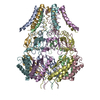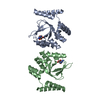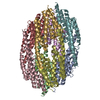+ Open data
Open data
- Basic information
Basic information
| Entry | Database: PDB / ID: 5y4o | ||||||||||||||||||
|---|---|---|---|---|---|---|---|---|---|---|---|---|---|---|---|---|---|---|---|
| Title | Cryo-EM structure of MscS channel, YnaI | ||||||||||||||||||
 Components Components | Low conductance mechanosensitive channel YnaI | ||||||||||||||||||
 Keywords Keywords | MEMBRANE PROTEIN / cryo-EM / MscS / Na/K selective channel | ||||||||||||||||||
| Function / homology |  Function and homology information Function and homology information | ||||||||||||||||||
| Biological species |  | ||||||||||||||||||
| Method | ELECTRON MICROSCOPY / single particle reconstruction / cryo EM / Resolution: 3.8 Å | ||||||||||||||||||
 Authors Authors | Zhang, Y. / Yu, J. | ||||||||||||||||||
| Funding support |  China, 5items China, 5items
| ||||||||||||||||||
 Citation Citation |  Journal: Protein Cell / Year: 2018 Journal: Protein Cell / Year: 2018Title: A binding-block ion selective mechanism revealed by a Na/K selective channel. Authors: Jie Yu / Bing Zhang / Yixiao Zhang / Cong-Qiao Xu / Wei Zhuo / Jingpeng Ge / Jun Li / Ning Gao / Yang Li / Maojun Yang /  Abstract: Mechanosensitive (MS) channels are extensively studied membrane protein for maintaining intracellular homeostasis through translocating solutes and ions across the membrane, but its mechanisms of ...Mechanosensitive (MS) channels are extensively studied membrane protein for maintaining intracellular homeostasis through translocating solutes and ions across the membrane, but its mechanisms of channel gating and ion selectivity are largely unknown. Here, we identified the YnaI channel as the Na/K cation-selective MS channel and solved its structure at 3.8 Å by cryo-EM single-particle method. YnaI exhibits low conductance among the family of MS channels in E. coli, and shares a similar overall heptamer structure fold with previously studied MscS channels. By combining structural based mutagenesis, quantum mechanical and electrophysiological characterizations, we revealed that ion selective filter formed by seven hydrophobic methionine (YnaI) in the transmembrane pore determined ion selectivity, and both ion selectivity and gating of YnaI channel were affected by accompanying anions in solution. Further quantum simulation and functional validation support that the distinct binding energies with various anions to YnaI facilitate Na/K pass through, which was defined as binding-block mechanism. Our structural and functional studies provided a new perspective for understanding the mechanism of how MS channels select ions driven by mechanical force. | ||||||||||||||||||
| History |
|
- Structure visualization
Structure visualization
| Movie |
 Movie viewer Movie viewer |
|---|---|
| Structure viewer | Molecule:  Molmil Molmil Jmol/JSmol Jmol/JSmol |
- Downloads & links
Downloads & links
- Download
Download
| PDBx/mmCIF format |  5y4o.cif.gz 5y4o.cif.gz | 280.7 KB | Display |  PDBx/mmCIF format PDBx/mmCIF format |
|---|---|---|---|---|
| PDB format |  pdb5y4o.ent.gz pdb5y4o.ent.gz | 216.5 KB | Display |  PDB format PDB format |
| PDBx/mmJSON format |  5y4o.json.gz 5y4o.json.gz | Tree view |  PDBx/mmJSON format PDBx/mmJSON format | |
| Others |  Other downloads Other downloads |
-Validation report
| Summary document |  5y4o_validation.pdf.gz 5y4o_validation.pdf.gz | 1008.2 KB | Display |  wwPDB validaton report wwPDB validaton report |
|---|---|---|---|---|
| Full document |  5y4o_full_validation.pdf.gz 5y4o_full_validation.pdf.gz | 1.2 MB | Display | |
| Data in XML |  5y4o_validation.xml.gz 5y4o_validation.xml.gz | 74.3 KB | Display | |
| Data in CIF |  5y4o_validation.cif.gz 5y4o_validation.cif.gz | 94.7 KB | Display | |
| Arichive directory |  https://data.pdbj.org/pub/pdb/validation_reports/y4/5y4o https://data.pdbj.org/pub/pdb/validation_reports/y4/5y4o ftp://data.pdbj.org/pub/pdb/validation_reports/y4/5y4o ftp://data.pdbj.org/pub/pdb/validation_reports/y4/5y4o | HTTPS FTP |
-Related structure data
| Related structure data |  6805MC M: map data used to model this data C: citing same article ( |
|---|---|
| Similar structure data |
- Links
Links
- Assembly
Assembly
| Deposited unit | 
|
|---|---|
| 1 |
|
- Components
Components
| #1: Protein | Mass: 39621.215 Da / Num. of mol.: 7 Source method: isolated from a genetically manipulated source Source: (gene. exp.)  Production host:  References: UniProt: P0AEB6 Has protein modification | Y | |
|---|
-Experimental details
-Experiment
| Experiment | Method: ELECTRON MICROSCOPY |
|---|---|
| EM experiment | Aggregation state: PARTICLE / 3D reconstruction method: single particle reconstruction |
- Sample preparation
Sample preparation
| Component | Name: YnaI / Type: COMPLEX / Entity ID: all / Source: RECOMBINANT |
|---|---|
| Source (natural) | Organism:  |
| Source (recombinant) | Organism:  |
| Buffer solution | pH: 6.5 |
| Specimen | Conc.: 0.1 mg/ml / Embedding applied: NO / Shadowing applied: NO / Staining applied: NO / Vitrification applied: YES |
| Specimen support | Grid material: COPPER / Grid mesh size: 400 divisions/in. / Grid type: Quantifoil R1.2/1.3 |
| Vitrification | Instrument: FEI VITROBOT MARK IV / Cryogen name: ETHANE / Humidity: 85 % / Chamber temperature: 277 K |
- Electron microscopy imaging
Electron microscopy imaging
| Experimental equipment |  Model: Titan Krios / Image courtesy: FEI Company |
|---|---|
| Microscopy | Model: FEI TITAN KRIOS |
| Electron gun | Electron source:  FIELD EMISSION GUN / Accelerating voltage: 300 kV / Illumination mode: FLOOD BEAM FIELD EMISSION GUN / Accelerating voltage: 300 kV / Illumination mode: FLOOD BEAM |
| Electron lens | Mode: BRIGHT FIELD |
| Image recording | Electron dose: 37 e/Å2 / Detector mode: SUPER-RESOLUTION / Film or detector model: GATAN K2 SUMMIT (4k x 4k) |
- Processing
Processing
| CTF correction | Type: PHASE FLIPPING AND AMPLITUDE CORRECTION |
|---|---|
| Symmetry | Point symmetry: C7 (7 fold cyclic) |
| 3D reconstruction | Resolution: 3.8 Å / Resolution method: FSC 0.143 CUT-OFF / Num. of particles: 42000 / Symmetry type: POINT |
 Movie
Movie Controller
Controller









 PDBj
PDBj

